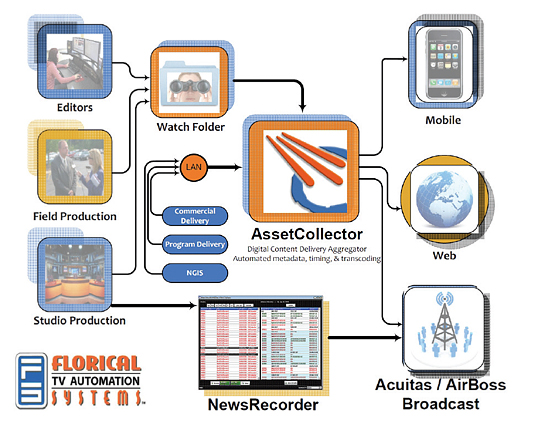Newsrooms Get Ripped and Ripe
LOS ANGELES
The IP revolution has made it much easier to get content in, mixed, and out to many more distribution systems in record time. This has delighted TV networks, as well as scared the hell out of them.
"You can run 100 channels almost out of someone's garage," said Shawn Maynard, vice president and general manager of Gainesville, Fla.-based automation systems provider Florical Systems. "If you want to stay in business over the next 10 years, you've got rethink your workflow and processes and provide a much more efficient way of doing business."
POWER TO THE CARD
At IBC next week, Florical Systems plans to showcase Acuitas, an all-in-one station-in-a-box (video server) product implemented with off-the-shelf hardware and "a true IT infrastructure," according to Maynard.
The key to its unique makeup is the inclusion of Matrox's X.mio2 card. The card's advanced hardware design processes much of the work that rival systems offload onto communication middleware.
"The middleware approach is very CPU-intensive, and can cause playback problems," said Maynard. "We're not stressing out the CPU—we're talking directly to the card: we get a significant layer of power and reliability from that card."

Florical's AssetCollector workflow with NewsRecorder and Acuitas At NAB, Florical also introduced two content management software options. NewsRecorder, when integrated with iNews or ENPS, pulls stories from the rundown and enables the recording of individual bites, easing the optimization of output to the Web, mobile devices and traditional TV play-out, said Maynard. AssetCollector gathers all other content for playback.
"With AssetCollector we can bring that content in with any metadata associated with it, and indicate availability of that content for playback, managing, thumbnails, and viewing within our larger suite," said Maynard. "It's a larger governing system to manage workflows and digital content from no matter [where] it comes [in] to [wherever] you play it out."
BROADER MANAGEMENT
Avid's Interplay product line now includes a media asset management tool as well as Version 2.2 of the Interplay Production solution that the Tewksbury, Mass.-based company debuted in 2006.
"Interplay has been very successful in providing a solution for managing shared media when you've got lots of different inbound material, a big editorial process and play-outs everywhere," said Craig Dwyer, senior director of product management, asset management for Avid. "Customers were asking for broader media asset management."
Following the acquisition of Germany-based MAM solutions provider Blue Order earlier this year, Avid has been busy remaking that company's Media Archive into Interplay Media Asset Manager and integrating it with Interplay Production and its iNEWS newsroom computer system. Both began shipping during the second quarter of 2010.
At IBC, Avid will demonstrate Interplay through workflow presentations and step-by-step walk-throughs illustrated by screen shots, said Dwyer.
IBC2010 will also witness the debut of Viz Video Hub 3, which, according to Vizrt, sports a fundamental redesign of its core architecture and a completely revamped user interface from the company's initial Viz Video Hub asset management product. Key to the upgrade is a scalable content delivery platform from Adactus (a Norwegian company that Vizrt acquired earlier this year), which is integrated into Vizrt's Escenic Content Engine platform.
TIVO-LIKE
Grass Valley will bring MediaFUSE FX to IBC. According to project manager Scott Matics, newsrooms constitute about 75 percent of the overall interest in the new "FX" re-purposing and multi-distribution system, which runs independent of Grass Valley's Ignite automation platform. At press time, the FX version could perform all but two tasks executed by the Ignite-driven version: 1) automatic segmentation and processing of stories to frame accuracy (the FX option is a manual process) and 2) automatic, on the fly replacement of content in live streamed video.
Since NAB, the company has added what Matics described as "a common tool that anybody in the news operation can use" to optimize daily news program content for various distribution points. It's part of the optional FuseENCODE package.
"It allows you to program the MediaFUSE encoding system like a TiVo," said Matics. "It will come on and encode whatever audio and video is being fed into it, shut off at a certain time and transfer whatever it recorded over to the FUSE-approved, multimedia management terminal. You can choose a pre-set to categorize it, add some metadata, trim it, create a slide show by capturing stills [for distribution to] Web sites (Flash format), iPad and iPhone publishing (H.264), BlackBerry (3GP)—it will chop it up, transcode it, and send it out to all those different publication points."
The new and improved version can also override watch folder pre-sets to select particular versus generic inputs for various play-outs. And it now includes a full HTML text editor that can add metadata, which is particularly useful for iPad publishing.
FISHING FOR NEWS
This year, Harris Corp. introduced new background architecture to its Invenio digital asset management technology and finessed the scheduling engine to better accommodate content delivery over wide area networks, said Chris Simon, vice president, automation and asset management.
"Up until now we've been focused on internal file transfer," said Simon. "We now include tools like FTP acceleration and network balancing to allow the efficient use of networks for distribution to [and from] remote services. You could use it for bringing in new material or distributing published material."
On the front end, Harris has also enabled preset modalities to cut the log-in time for scheduled live incoming streams. And it renamed its Citizen Journalist smartphone application "NewsFish," while optimizing it for a variety of mobile device formats so reporters can better capture video, tag it with metadata, and file it with a news operation for its Invenio database and Velocity editors.
"You can feed that [content] out to your newsroom systems no matter what the format or source of the material," said Simon. "You can publish it out into multiple formats [HDTV, web TV, mobile apps] at the same time."
The professional video industry's #1 source for news, trends and product and tech information. Sign up below.
